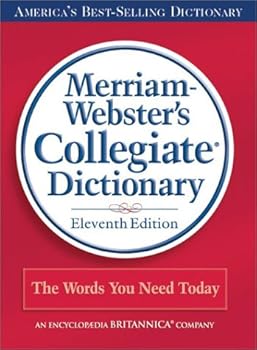

*Starred Review* The first Merriam-Webster's Collegiate Dictionary (M-W) was published in 1898, and the tenth edition had a copyright date of 1993. The eleventh edition brings many new words, a CD-ROM, and a free one-year subscription to Merriam-Webster Collegiate.com, which includes the text of the dictionary as well as the Collegiate Thesaurus, Collegiate Encyclopedia, and Merriam-Webster's Spanish-English Dictionary.
Now for the numbers. M-W has a paper file of 15,700,000 citations from which their lexicographers chose 10,000 new words, for a total of 165,000 entries and 225,000 definitions. There are 100,000 "changes" from the tenth edition. Users asked for more usage examples and idioms and phrases, so there are now 40,000 examples and a "significant" increase in idioms. There are 91,000 pronunciations, 33,000 etymologies, 2,700 illustrative quotations, 650 foreign words and phrases, and 700 illustrations.
As the world rushes on, so does the time taken for words to become accepted. It used to be at least ten years before a new word was considered for inclusion; now it may take as few as four years. M-W staff certainly have become the purveyors of the words that we use. Terms added to this edition include Botox, comb-over, crunch-exercise, dead-cat bounce, dead presidents, dead tree, def, exfoliant, gimme cap, identity theft, phat, and tweener. As would be expected, some entries had to be eliminated because words are invented faster than they go out of favor. Anyone seeking definitions of record changer and pantdress will need an unabridged or older dictionary.
M-W still includes separate sections for geographical and biographical names, but abbreviations are now interfiled in the main section. Perhaps the next edition will interfile the other two sections.
Criticisms of the eleventh edition are mostly cosmetic. The use of photographs and shaded boxes for usage notes would make it more attractive to users. There are, however, more than 200 new black-and-white line drawings. The Col legiate Dictionary's closest competitor, the American Heritage College Dictionary (4th ed.), published last year, makes good use of photographs and illustrations in the margins. It contains a number of words (gangsta, goth) that are also new to this edition of M-W.
The online version has a number of search options, including a reverse dictionary (if you can think of the correct words), the etymology of words, and those that are the same part of speech. The most interesting option is the date feature. Paging through the words attributed to a particular year is a definite retrospective of recollections. Words of 1980 include balsamic vinegar, exit poll, NIMBY, and ziplock. An improvement to the online version would be a search button so the back button doesn't need to be used as much. It would be less cumbersome if the illustrations were included with the definitions rather than requiring another click. Because the one-year free subscription to the online version is only mentioned on the dust jacket, some users will fail to see it. Unfortunately, the free subscription is not available free to libraries or schools. One wonders if the CD-ROM is really necessary because it provides only basic searching.
For serious dictionary collections and fans of dictionaries from this venerable publisher, now in partnership with Britannica, the eleventh edition is a definite buy. With a list price of $25.95, it is a bargain for individuals. Libraries with limited budgets that purchased the American Heritage College Dictionary in 2002 may not need another college dictionary this year. RBB
Copyright © American Library Association. All rights reserved
DOWNLOAD MERRIAM-WEBSTER'S COLLEGIATE DICTIONARY. 11TH EDITION - MERRIAM-WEBSTER
Hiç yorum yok:
Yorum Gönder